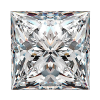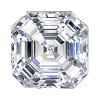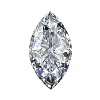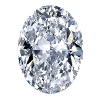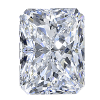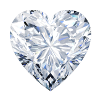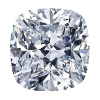Diamond Education
Anatomy of a Diamond
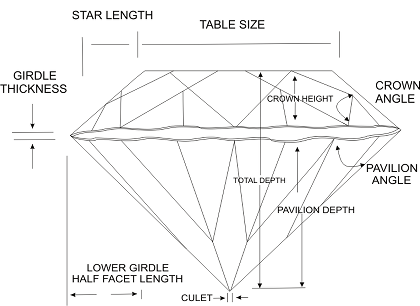
Diamond Shape
Typically, there are 10 different shapes of diamonds: round, princess, asscher, radiant, cushion, emerald, marquise, oval, pear, and heart. Depending on preference and occasion, any one of these diamonds could be a perfect shape for you. Every shape other than a round cut shape is considered to be a fancy cut. Each shape is unique and is important in buying diamonds because it determines the brilliance of a diamond (light reflected, sparkle, etc.).
Round
When people think of diamonds, the round shape is typically imaged. Because they are such a classic and maintain a bright sparkle, round cut diamonds remain very popular around the world. Round diamonds have a very good cut that allows even a lower clarity or color grade to produce a fairly bright sparkle, another reason it is such a popular shape. Being the most expensive cut, when a round diamond is cut and processed, it loses more of its carat weight than any other shape.
Princess
As the second most popular shape, the admiration of the princess cut has been growing since it was introduced in the 1980's. Because of the way they are cut, the princess shape tends to hide any inclusions that help with pronouncing the sparkle. However, the way this particular shape is cut also tends to make the color look more prominent in the diamond. When being cut and processed, this shape retains most of its carat weight, and the final product tends to be less costly.
Round
The emerald cut is a more rectangular version of the asscher shaped diamond and has cut corners with step facets coming off each other, however, there are not many. Because of the small amount of facets in the diamond and amount of rough it retains during processing, this is a popular option for those who are on a lower budget.
Asscher
The asscher shaped diamond is not the most popular shape. However, it is the center of many vintage pieces including many of today's vintage style engagement rings. Unlike the princess shaped diamond, the way that asscher shape is cut tends to magnify imperfections; therefore, it is recommended to get a higher quality of clarity to minimize visual flaws.
Round
Because the marquise shaped diamond is long and narrow, it tends to create the illusion of the person wearing it to have longer, more slender fingers. Their extended length creates the ability for them to look bigger than any other diamond shape of the same carat weight.
Oval
The oval shaped diamond is a spinoff of the round shape. With a longer length, it is similar to the marquise cut in that it tends to make your fingers look elongated and more slender.
Radiant
As an alternative to the emerald cut, the radiant cut diamond has a 70 facet cut that amplifies any shine that it already had. Again, the way this particular diamond is cut, it has a tendency to amplify color that makes it necessary to go with a diamond color of higher quality such as an H or better.
Pear
The pear shaped diamond is a combination of the round and marquise shape due to its tapered point at one end. These diamonds are unique because although there is a point, there are no straight edges. These diamonds can vary in width whereas the narrower cuts would be ideal for earrings while the more widely cut diamonds would be ideal for rings.
Heart
The heart is the ultimate symbol of love, which is why this particular shape of diamond is popular for many solitaire rings and pendants. Because the symmetry on a heart must be perfect, the cleft where the two halves meet must be sharp and distinct while the wings are slightly rounded. Like the pear shaped diamond, hearts are available in a wider or narrower ratio.
Cushion
Along with the Asscher cut, the cushion cut is a favorite center diamond for the vintage style jewelry and engagement rings. The cushion shape gets its name because it seems to look like a pillow. As time has passed, the way a cushion diamond is cut has been evolved to include more facets, which gives it a brighter, more pronounced sparkle and fire.
Cut, color, clarity, carat weight
When looking for your perfect diamond, it is necessary to know the ins and outs of each characteristic of a diamond- the 4 C's: cut, color, clarity, and carat weight. Each "C" contributes to the overall quality of each diamond and influences the price you will pay. It is necessary to have your diamond professionally graded to ensure that you are getting the quality of diamond you purchase. GIA is a globally known professional diamond grading laboratory and was the first to create the standard for grading diamonds going by the 4 C's. When GIA completes the grading of any particular diamond, they will give you a diamond grading report upon purchase of a diamond. Also, after GIA has graded a diamond, it will be inscribed with a verification number. A verification number ensures that the quality matches your grading report; this is also important to have in case your diamond is ever lost or stolen. Before learning about what the 4 C's are in depth, it is essential to know the anatomy of a diamond.
Often, customers want to know which "C" is the most important for a brilliant looking diamond. Most jewelers will tell you that the cut is the most important characteristic of a diamond due to the purpose: creating the sparkle.
-
Cut
When many people think of a diamond cut, they are typically thinking of the shape (round, pear, marquise, etc.). However, the cut refers to the quality and amount of light that passes through a diamond.
When a diamond is cut properly at the highest quality or an "ideal cut," the greatest possible amount of light reflection will occur in the diamond, creating their famous sparkle. The lowest quality cut diamond, or "poor cut" refers to a severely shallow or deeply cut diamond.
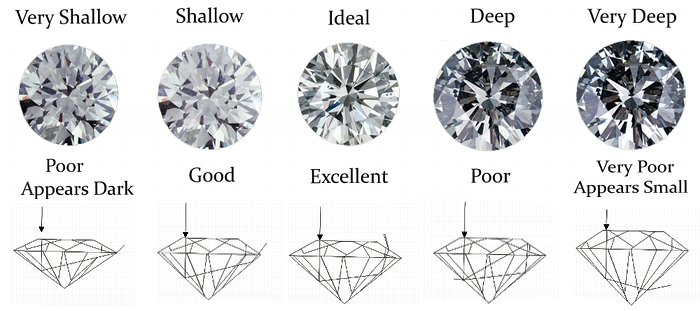
If a diamond is cut too deeply or shallow, it can reduce the shine and, consequently, reduce the value. If a diamond is cut too shallow, it will allow light to pass straight through and create a more dull looking diamond. Likewise, if the diamond is cut too deeply, light will hit the diamond in a way that it will be reflected from the side on the bottom, also reducing the amount of sparkle that is desired.
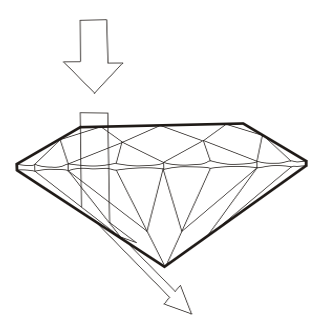
Too Shallow
Light escapes from the bottom, causing the diamond to appear dull and lifeless. Creates a black center when viewed from above.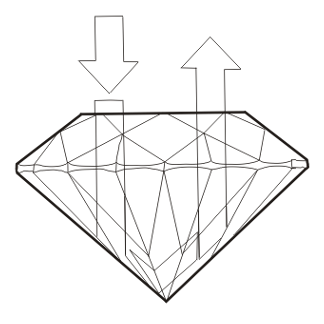
Ideal Cut
Perfectly proportioned, the maximum amount of light is reflected back through the top of the diamond.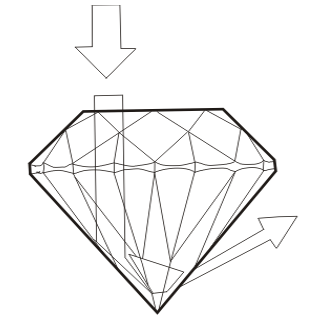
Too Deep
Light escapes from the sides, causing the diamond to loose brilliance. Creates and opaque and glassy look.Brilliance, Fire and Scintillation
A diamond's cut grade is based on three different types of reflection: brilliance, dispersion (fire), and scintillation. The facets in a diamond reflect light and bounces it from facet to facet, and when a diamond is cut properly, the greatest amount of white light is reflected, creating the brilliance of a diamond. When you see the rainbow colors being reflected off a diamond, this is referred to as the "fire" of a diamond. Lastly, the scintillation is the reason behind the sparkling on a diamond's surface due to the light reflections in all directions. Scintillation has two components to the sparkle it creates: flash scintillation and fire scintillation.
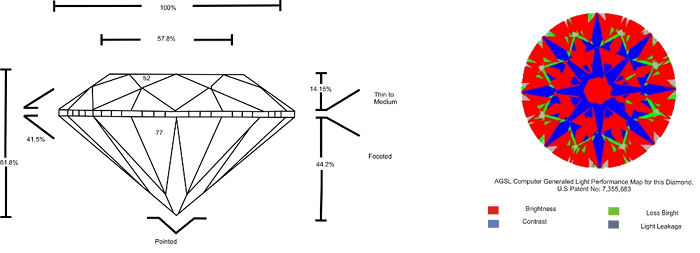
To have fire and flash, you must have a reflection of light that requires movement of either the diamond or the observer. Because the fire was explained to be the colorful reflections of light, the white sparkles that are seen in diamonds is the flash. Seeing the flash of a diamond is more common than seeing the fire because, with flash, there are more light environments that allow reflection. When looking at a flash scintillation map, you can see that there are more areas where flash is likely to be seen. In a fire scintillation map, there are fewer areas for a colorful sparkle to occur vs. a white sparkle for the flash. A scintillation patterning map will show you where larger sparkles will occur vs. smaller.
Hearts and Arrows
Hearts and arrows is a phenomenon that began in 1988 where, in a round cut diamond, you can see the patterns of hearts and arrows inside. The more ideally cut the diamond is, the easier it is to see the hearts and arrows. When a round diamond is facing up, you can see arrows; when it is facing down, you can see hearts. Although having hearts and arrows does not affect the price, it is a way to prove that the diamond is, in fact, an ideal cut.
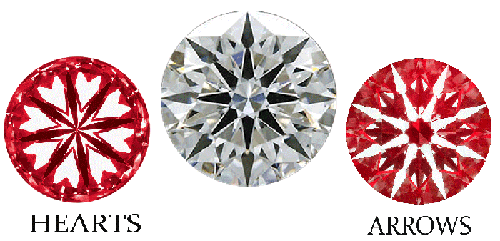
Symmetry and polish play an important role in how much a diamond sparkles as well. Symmetry refers to how well the facets in a diamond align at a certain point. The more aligned facets are, the more sparkle will be given off. Symmetry is important in diamonds with a VVS2 clarity and higher because fair and poor symmetry will tend to pronounce any imperfections in the clarity. A well-polished diamond is important for sparkle as well. A poorly polished diamond will resemble a glass with soap scum residue on it, reducing the amount of light that can be reflected.
-
Color
If you have ever looked at diamonds in a jewelry store, you have probably noticed that some diamonds appear to vary in shades. Some diamonds seem to be crystal clear while others have a yellow tint; this is referred to as the color of a diamond, or the degree of how colorless it is.
Looking at a chart, you will see that diamond colors range from the rarest form D, which is completely colorless and most desirable, to Z, which appears to be almost yellow.
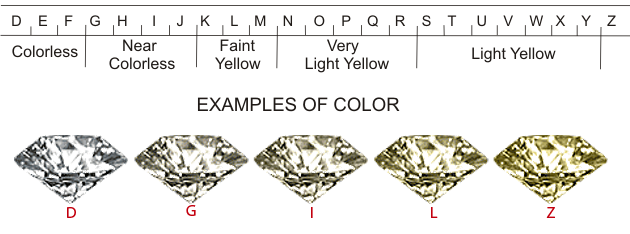
Color Scale. D = rarest and most desirable The diamond color chart is split up into sections; D-F are considered colorless, G-J are considered to be near colorless, K-M are slightly yellow, and N-Z are considered light yellow or brown. Although a Z color diamond appears to be yellow, it is still considered "white" because fancy diamonds such as sapphires, rubies, and champagnes have their personal color scale.
A diamond with a higher color grade will seem to have a more colorful fire, meaning that you will see more reflections of rainbow characterized colors. The more colorless diamonds (D-F) should be set in white gold or platinum because yellow gold reflects the color that would take away from the high-quality diamond's colorless effect.
Most color variations of the diamond are almost undetectable by the naked eye; however, it will greatly affect the quality and price of the diamond. Almost every diamond's color graded today is graded by the GIA chart, whether it was actually graded by GIA or not. (TIP: if your diamond's color contains two scale ratings such as G-H, the diamond was not graded, it was just estimated by a jeweler)
-
Clarity
A diamond's clarity refers to the amount of Blemishes or Inclusions that are visible under 10X magnification. The difference between blemishes and inclusions is that blemishes are imperfections that occur on the surface of the diamond while inclusions are imperfections that take place inside the diamond.
Following are the different imperfections that are categorized as blemishes or inclusions:
Blemishes
Abrasions

Abrasions are rough patches on a diamond's facet, typically cased by a cutter's error while polishing a rough diamond. Natural

When a diamond is processed, the rough is usually cut out; however, there are some remains after the process; this is called a natural blemish. Nick

A nick is similar to a chip but of a very small size. Pit

Pits are tiny opening on the diamond surface. Polish Lines

Polish lines are regular streaks left behind from the diamond polishing process. Burn Mark

These are blemishes caused due to excessively rapid polishing action which can generate sufficient heat to cause a burn. Scratch

Usually caused by improper storage of loose diamond with other diamond. Surface Graining

An irregularity in the grain structure on the surface of a diamond. Extra Facet

An extra facet is one that is not part of the standard cut of a diamond. Sometimes the roughness of the stone can cause the cutter to create and extra facet. Inclusions
Bruise

A bruise is like a chip, but it also includes root-like feathers that go into the diamond. Cavity

Like teeth, a cavity in a diamond is an opening on the surface and is usually the result of a natural flaw because the stone is rough. Chip

A chip is just what you would imagine it to be like a chip in glass, a small piece missing on the surface usually due to cutting. Cleavage

Cleavages are fracture that occur along a cleavage plane within a diamond crystal structure. Cloud

When a diamond is hot and under pressure, extra crystals, or a group of pinpoints, can bind to the diamond creating a cloud. Crystal

A mineral deposit that usually appears black and can show up alone or in groups. Feather

Usually white or transparent, a feather resembles a hairline fracture with fine lines radiating from it. Grain Center

Grain Center description Indented Natural

An indentation is exactly a natural blemish but instead of a diamond remain, it slightly indents the diamond's surface. Internal Graining

An irregularity in the grain structure inside a diamond. Twinning Wisp

When a crystal grows, natural distortions will occur that look like flat ribbon pinpoints or clouds. Knot

A knot is a more rare inclusion and is a diamond crystal that has found its way to the surface of a diamond. They sometimes resemble raised areas on a facet or group of facets. Knots are a potential durability risk, therefore, some jewelers do not carry diamonds with this inclusion. Laser Drill-hole

A drill hole is a pinpoint hole on the surface of a diamond that leads to a microscopic tunnel. It is often drilled to remove an internal inclusion; however, the diamond is then considered to be enhanced. Many jewelers do not carry enhanced diamonds. Needle

A needle is similar to a feather except it does not have any fine lines radiating from the inclusion. Pinpoint

Very small crystals that bind to a diamond. Depending on how many inclusions are in a diamond, it will be categorized on a scale of least inclusions to most inclusions as follows:
- FL/IF (flawless or internally flawless)
- VVS1/VVS2 (very, very slightly included)
- VS1/VS2 (very slightly included)
- SI1/SI2 (slightly included)
- I1/I2/I3 (included).
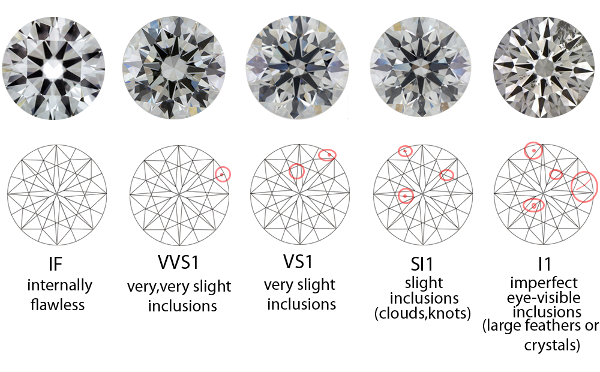
The more inclusions a diamond contains, the less the diamond will be of value.
A Flawless/Internally Flawless diamond has no inclusions visible even under 10X magnification. They can be paired together because neither diamond will have inclusions, and only the internally flawless diamond will contain blemishes. Both clarities of diamond are very rare.
A VVS1-VS2 has visible blemishes or inclusions under a 10X microscope, however, they are difficult to see.
S1 and S2 have inclusions that are more noticeable under a 10X microscope.
I1-I3 have obvious inclusions which dramatically reduces the price and value of a diamond because it often affects the transparency and brilliance. Keep in mind that I1/I2/I3 diamonds have so many inclusions that it may affect the diamond's durability too, and most jewelers will not even sell them.
-
Carat
When shopping, you will notice that the carat of a diamond will be stated; this refers to the carat weight of the diamond, or how much the diamond weighs.
The metric unit for one carat is described as 200 milligrams, or 100 points. The points of a diamond allow for a more accurate measurement because it allows you to read the diamond's carat weight to the nearest one-hundredth decimal place.
Carat weight is measured by the distance across the top of a diamond in mm and the diamond's cut grade/density, therefore, one carat weight of a certain shape of diamond may look bigger than a different shape of the same carat weight. For example, a one carat marquise-shaped diamond will appear to be bigger than a one carat round shaped diamond because of the way each diamond must be cut.
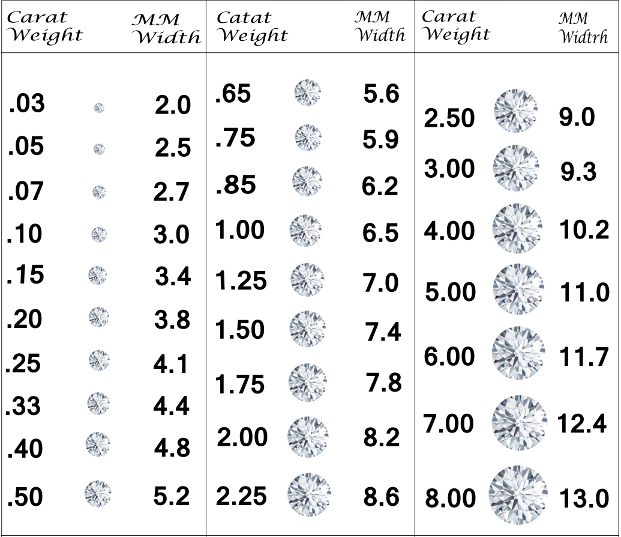
The higher the carat, the easier it is to see imperfections, therefore, when buying a diamond over 2 carats, you may want to make sure the diamond is of VS2 clarity or higher. Although the higher the carat weight, the higher the value of the diamond, you cannot forget that the other 3 C's play a part in influencing the price. A 2 carat diamond with the most rare cut, color, and clarity may be more expensive than a 3 carat diamond with the lowest quality of color, cut, and clarity.
A fifth C?
Although the four C's are important, we like to believe there is a fifth C because it plays a large role in how a diamond retains its brilliance: Care.
Diamond care is critical if you want it to remain bright. It is recommended that you clean your diamonds and jewelry often and that you take time at least once a year to have your diamonds inspected and professionally cleaned. If you can do so, you can avoid costly repairs and replacements of your diamond down the road.


